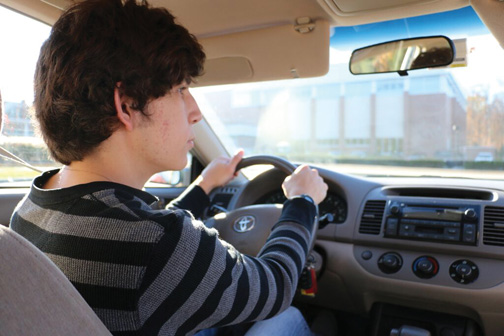Christian Stahly, recently licensed driver and junior, was introduced to driver education in a way typical to many CHS students: receiving a flyer advertising the class during one of his lunch periods in freshman year. There was no personal research involved nor extensive conferences with counselors.
 “I never really thought about it. It was just, ‘Driver’s ed, that’s what you’re going to do,’” Stahly said.
“I never really thought about it. It was just, ‘Driver’s ed, that’s what you’re going to do,’” Stahly said.
For many parents and administrators, driver education is an acceptable compromise between their children’s eagerness to drive and their own anxieties about their children’s safety. The textbook instruction offered through the Central Indiana Educational Service Center (CIESC) driver education program and the flexible schedule of the CIESC’s online driver education course is primarily accountable for what TeLisa Smith, coordinator of the CIESC driver education program, has observed as a steady increase in CHS student attendance in the program.
However, though driver education may be the first choice for conditioning educated drivers, educated drivers are not always safe drivers. According to the Insurance Institute for Highway Safety (IIHS), a nonprofit highway data institute run by insurers, and the U.S. Department of Transportation’s Fatality Analysis Reporting System, there is little empirical evidence for the safety benefits of driver education, though the general trend for teenagers involved in fatal motor vehicle accidents shows that, in 2013, 71 percent fewer teenagers died in accidents than in 1975 and 11 percent fewer teenagers died in accidents than in 2012.
Saying that the rise of driver education participation does not substantially contribute to these positive statistics may seem counterintuitive. However, according to the IIHS, there lies a second system of driver safety protocols that driver education has to work within: graduated drivers licensing (GDL). Introduced in Florida in 1996, GDL has since spread to every state. GDL in Indiana is responsible for many of the rules CHS student drivers are familiar with, such as the minimum learner’s permit age of 16, a road test prerequisite to a license and limits on driving in high-risk situations such as at night or with underage passengers.
However, according to the IIHS, poor skills are not always to blame for teenage driving accidents; teenagers’ attitudes, experience and decision-making matter just as much if not more than technical skills and knowledge. Many teenagers tend to overestimate their abilities and underestimate their vulnerabilities, aspects of psychology that training and education may struggle to regulate. In this area, the natural role and responsibilities of a parent could be the most consistently effective treatment.
 Junior Brett Kahlow received his learner’s permit this year in early August. Kahlow represents the increasingly uncommon demographic of CHS students who opt to not take the driver education program.
Junior Brett Kahlow received his learner’s permit this year in early August. Kahlow represents the increasingly uncommon demographic of CHS students who opt to not take the driver education program.
“I felt like my parents could teach me more about how to actually stay safe on the roads rather than just the basics that you would be taught in driver education, the quirks of driving rather than the core education of what to do at a stop sign,” Kahlow said.
It is not to say, however, that parents and guardians always offer the safer alternative to driver education.
Smith said, “As parents, we’ve been driving for some years, so we may have built those bad habits. We’ve been in and out of traffic, things like that. Not to say every parent is like that, but, you know, getting the basic skills to know what is right and what is wrong is very important.”
In addition to offering an unbiased, objective instruction on road safety, driver education also offers a vast number of practical privileges that are exclusive to its students, such as an earlier licensing eligibility age at 16 years and three months as opposed to 16 and nine months.
“Driver’s ed does teach to the exam…Other people would have to read the manual, and I didn’t really have to do that…It’s really relaxed if you do it online, and it’s just whenever you have time,” Stahly said.
Though there is no direct evidence that students who take a driver education class are better suited for the road, many people like Smith still believe in the advantages of taking a class that offers an official and standardized education of the road.
Learning from parents and learning from driver education have their pros and cons. At the end of the day, it is still up to the student whether or not the speedometer obeys the speed limit.
Smith said, “We’ve got a lot of cars out here on the street, and I would like for as many students to go through the course that can (to) get the proper training and skills that they need to be safe drivers.”

































![AI in films like "The Brutalist" is convenient, but shouldn’t take priority [opinion]](https://hilite.org/wp-content/uploads/2025/02/catherine-cover-1200x471.jpg)









































![Review: “The Immortal Soul Salvage Yard:” A criminally underrated poetry collection [MUSE]](https://hilite.org/wp-content/uploads/2025/03/71cju6TvqmL._AC_UF10001000_QL80_.jpg)
![Review: "Dog Man" is Unapologetically Chaotic [MUSE]](https://hilite.org/wp-content/uploads/2025/03/dogman-1200x700.jpg)
![Review: "Ne Zha 2": The WeChat family reunion I didn’t know I needed [MUSE]](https://hilite.org/wp-content/uploads/2025/03/unnamed-4.png)
![Review in Print: Maripaz Villar brings a delightfully unique style to the world of WEBTOON [MUSE]](https://hilite.org/wp-content/uploads/2023/12/maripazcover-1200x960.jpg)
![Review: “The Sword of Kaigen” is a masterpiece [MUSE]](https://hilite.org/wp-content/uploads/2023/11/Screenshot-2023-11-26-201051.png)
![Review: Gateron Oil Kings, great linear switches, okay price [MUSE]](https://hilite.org/wp-content/uploads/2023/11/Screenshot-2023-11-26-200553.png)
![Review: “A Haunting in Venice” is a significant improvement from other Agatha Christie adaptations [MUSE]](https://hilite.org/wp-content/uploads/2023/11/e7ee2938a6d422669771bce6d8088521.jpg)
![Review: A Thanksgiving story from elementary school, still just as interesting [MUSE]](https://hilite.org/wp-content/uploads/2023/11/Screenshot-2023-11-26-195514-987x1200.png)
![Review: "When I Fly Towards You", cute, uplifting youth drama [MUSE]](https://hilite.org/wp-content/uploads/2023/09/When-I-Fly-Towards-You-Chinese-drama.png)
![Postcards from Muse: Hawaii Travel Diary [MUSE]](https://hilite.org/wp-content/uploads/2023/09/My-project-1-1200x1200.jpg)
![Review: "Ladybug & Cat Noir: The Movie," departure from original show [MUSE]](https://hilite.org/wp-content/uploads/2023/09/Ladybug__Cat_Noir_-_The_Movie_poster.jpg)
![Review in Print: "Hidden Love" is the cute, uplifting drama everyone needs [MUSE]](https://hilite.org/wp-content/uploads/2023/09/hiddenlovecover-e1693597208225-1030x1200.png)
![Review in Print: "Heartstopper" is the heartwarming queer romance we all need [MUSE]](https://hilite.org/wp-content/uploads/2023/08/museheartstoppercover-1200x654.png)




